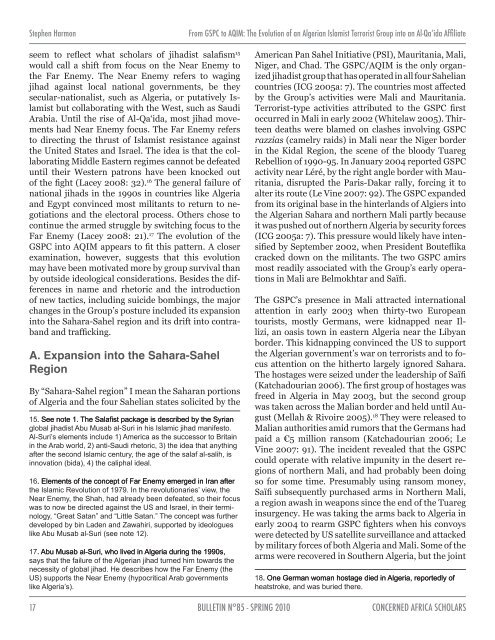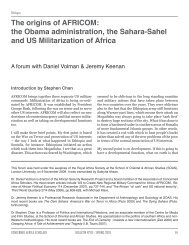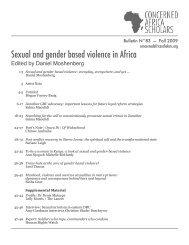Western Sahara and the United States' geographical imaginings
Western Sahara and the United States' geographical imaginings
Western Sahara and the United States' geographical imaginings
Create successful ePaper yourself
Turn your PDF publications into a flip-book with our unique Google optimized e-Paper software.
Stephen Harmon From GSPC to AQIM: The Evolution of an Algerian Islamist Terrorist Group into an Al-Qa‘ida Affiliate<br />
seem to reflect what scholars of jihadist salafism 15<br />
would call a shift from focus on <strong>the</strong> Near Enemy to<br />
<strong>the</strong> Far Enemy. The Near Enemy refers to waging<br />
jihad against local national governments, be <strong>the</strong>y<br />
secular-nationalist, such as Algeria, or putatively Islamist<br />
but collaborating with <strong>the</strong> West, such as Saudi<br />
Arabia. Until <strong>the</strong> rise of Al-Qa‘ida, most jihad movements<br />
had Near Enemy focus. The Far Enemy refers<br />
to directing <strong>the</strong> thrust of Islamist resistance against<br />
<strong>the</strong> <strong>United</strong> States <strong>and</strong> Israel. The idea is that <strong>the</strong> collaborating<br />
Middle Eastern regimes cannot be defeated<br />
until <strong>the</strong>ir <strong>Western</strong> patrons have been knocked out<br />
of <strong>the</strong> fight (Lacey 2008: 32). 16 The general failure of<br />
national jihads in <strong>the</strong> 1990s in countries like Algeria<br />
<strong>and</strong> Egypt convinced most militants to return to negotiations<br />
<strong>and</strong> <strong>the</strong> electoral process. O<strong>the</strong>rs chose to<br />
continue <strong>the</strong> armed struggle by switching focus to <strong>the</strong><br />
Far Enemy (Lacey 2008: 21). 17 The evolution of <strong>the</strong><br />
GSPC into AQIM appears to fit this pattern. A closer<br />
examination, however, suggests that this evolution<br />
may have been motivated more by group survival than<br />
by outside ideological considerations. Besides <strong>the</strong> differences<br />
in name <strong>and</strong> rhetoric <strong>and</strong> <strong>the</strong> introduction<br />
of new tactics, including suicide bombings, <strong>the</strong> major<br />
changes in <strong>the</strong> Group’s posture included its expansion<br />
into <strong>the</strong> <strong>Sahara</strong>-Sahel region <strong>and</strong> its drift into contrab<strong>and</strong><br />
<strong>and</strong> trafficking.<br />
A. Expansion into <strong>the</strong> <strong>Sahara</strong>-Sahel<br />
Region<br />
By “<strong>Sahara</strong>-Sahel region” I mean <strong>the</strong> <strong>Sahara</strong>n portions<br />
of Algeria <strong>and</strong> <strong>the</strong> four Sahelian states solicited by <strong>the</strong><br />
5. . S���� S���� ����� ����� . T���� T���� S�������� S�������� p��k���� p��k���� ��� ��� ��������b��� ��������b��� by ����� ����� Sy���� Sy����<br />
���b�� j��������� Ab� M����b ���S��� �� ����� I����m�� j����� m����������.<br />
A��S���’�� �����m������ �������� �� Am������ ��� ����� ������������� �� B������<br />
�� ����� A��b w����, �� �����S���� ����������, 3�� ����� ����� ����� ��y������<br />
������ ����� �������� I����m�� �������y, ����� ���� �� ����� ������ ����������, ���<br />
����v����� �b�����, �� ����� ����p���� ������.<br />
6. . E���m������ E���m������ �� �� ����� ����� ������p� ������p� �� �� F�� F�� E���my E���my ��m������� ��m������� �� �� I��� I��� ������ ������<br />
����� I����m�� R��v������� �� 9 9. I� ����� ���v��������������’ v���w, �����<br />
N���� E���my, ����� S�����, ���� �������y b����� �����������, ��� ������� ������<br />
w��� �� ��w b�� ���������� �������� ����� US ��� I�������, �� ������� ����m��<br />
�����y, “G����� S����” ��� “������� S����.” T���� ������p� w��� ���������<br />
���v����p��� by b�� ������ ��� ��w������, ���pp������ by �������������<br />
��k�� Ab� M����b ���S��� ������� ����� ��.<br />
. Ab� Ab� M����b M����b ���S���, ���S���, w��� w��� ��v��� ��v��� �� �� A������� A������� ������ ������ ����� ����� 990��, 990��,<br />
���y�� ����� ����� �������� �� ����� A�������� j����� ������� ���m ��w����� �����<br />
������������y �� ���b�� j�����. H�� ��������b���� ���w ����� F�� E���my ������<br />
US�� ���pp����� ����� N���� E���my ���yp��������� A��b ��v����m������<br />
��k�� A�������’����.<br />
1<br />
BULLETIN N°85 - SPRING 2010<br />
American Pan Sahel Initiative (PSI), Mauritania, Mali,<br />
Niger, <strong>and</strong> Chad. The GSPC/AQIM is <strong>the</strong> only organized<br />
jihadist group that has operated in all four Sahelian<br />
countries (ICG 2005a: 7). The countries most affected<br />
by <strong>the</strong> Group’s activities were Mali <strong>and</strong> Mauritania.<br />
Terrorist-type activities attributed to <strong>the</strong> GSPC first<br />
occurred in Mali in early 2002 (Whitelaw 2005). Thirteen<br />
deaths were blamed on clashes involving GSPC<br />
razzias (camelry raids) in Mali near <strong>the</strong> Niger border<br />
in <strong>the</strong> Kidal Region, <strong>the</strong> scene of <strong>the</strong> bloody Tuareg<br />
Rebellion of 1990-95. In January 2004 reported GSPC<br />
activity near Léré, by <strong>the</strong> right angle border with Mauritania,<br />
disrupted <strong>the</strong> Paris-Dakar rally, forcing it to<br />
alter its route (Le Vine 2007: 92). The GSPC exp<strong>and</strong>ed<br />
from its original base in <strong>the</strong> hinterl<strong>and</strong>s of Algiers into<br />
<strong>the</strong> Algerian <strong>Sahara</strong> <strong>and</strong> nor<strong>the</strong>rn Mali partly because<br />
it was pushed out of nor<strong>the</strong>rn Algeria by security forces<br />
(ICG 2005a: 7). This pressure would likely have intensified<br />
by September 2002, when President Bouteflika<br />
cracked down on <strong>the</strong> militants. The two GSPC amirs<br />
most readily associated with <strong>the</strong> Group’s early operations<br />
in Mali are Belmokhtar <strong>and</strong> Saïfi.<br />
The GSPC’s presence in Mali attracted international<br />
attention in early 2003 when thirty-two European<br />
tourists, mostly Germans, were kidnapped near Illizi,<br />
an oasis town in eastern Algeria near <strong>the</strong> Libyan<br />
border. This kidnapping convinced <strong>the</strong> US to support<br />
<strong>the</strong> Algerian government’s war on terrorists <strong>and</strong> to focus<br />
attention on <strong>the</strong> hi<strong>the</strong>rto largely ignored <strong>Sahara</strong>.<br />
The hostages were seized under <strong>the</strong> leadership of Saïfi<br />
(Katchadourian 2006). The first group of hostages was<br />
freed in Algeria in May 2003, but <strong>the</strong> second group<br />
was taken across <strong>the</strong> Malian border <strong>and</strong> held until August<br />
(Mellah & Rivoire 2005). 18 They were released to<br />
Malian authorities amid rumors that <strong>the</strong> Germans had<br />
paid a €5 million ransom (Katchadourian 2006; Le<br />
Vine 2007: 91). The incident revealed that <strong>the</strong> GSPC<br />
could operate with relative impunity in <strong>the</strong> desert regions<br />
of nor<strong>the</strong>rn Mali, <strong>and</strong> had probably been doing<br />
so for some time. Presumably using ransom money,<br />
Saïfi subsequently purchased arms in Nor<strong>the</strong>rn Mali,<br />
a region awash in weapons since <strong>the</strong> end of <strong>the</strong> Tuareg<br />
insurgency. He was taking <strong>the</strong> arms back to Algeria in<br />
early 2004 to rearm GSPC fighters when his convoys<br />
were detected by US satellite surveillance <strong>and</strong> attacked<br />
by military forces of both Algeria <strong>and</strong> Mali. Some of <strong>the</strong><br />
arms were recovered in Sou<strong>the</strong>rn Algeria, but <strong>the</strong> joint<br />
�. . ���� ���� G���m�� G���m�� w�m�� w�m�� ���������� ���������� ����� ����� �� �� A�������, A�������, ���p�������y ���p�������y �� ��<br />
�����������k��, ��� w��� b������ ��������.<br />
CONCERNED AFRICA SCHOLARS




